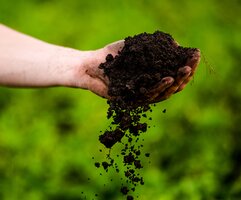Soil Types

Gardens can vary a lot even within the same neighbourhood. Understanding your soil helps you choose the right plants and improve growing conditions. In this article we'll cover your gardens soil type, how to identify the soil type and how to work with each soil type.
Clay Soil
Characteristics
-
Heavy, sticky when wet; cracks when dry
-
Holds nutrients well
-
Slow to warm up in spring
Pros & Cons
Clay soils are nutrient-rich and suit more moisture-loving plants. The downside is poor drainage and they can be difficult to dig, especially in wet conditions
Plants that do well
Roses, asters, hydrangeas, hostas, fruit trees (apple/pear), many grasses.
Sandy Soil
Characteristics
-
Gritty texture; drains very quickly
-
Warms up fast in spring
-
Low in nutrients
Pros & Cons
Easy to dig and work with and the soil drains very quickly, so you get less waterlogging. The downside of this is that the nutrients wash through the soil quite quickly and it can dry out and crack in prolonged dry conditions.
Plants that do well
Lavender, rosemary, thyme, sedums, grasses, many Mediterranean plants, carrots.
Silt Soil
Characteristics
-
Smooth, silky feel
-
Retains moisture better than sand but drains better than clay
-
Fertile and workable
Pros & Cons
A Good balance of drainage and moisture makes this soil easy to work with, however it can compact quite easily.
Plants that do well
Most vegetables, shrubs, roses, many perennials.
Loam Soil
Characteristics
-
Balanced mix of clay, sand, and silt
-
Soft, crumbly texture
-
Excellent drainage and nutrient retention
Pros & Cons
This is generally regarded as the best all-round soil with most plants liking the growing conditions.
Plants that do well
Virtually all garden plants.
Chalky Soil
Characteristics
-
Often pale, stony, and alkaline
-
Drains freely
-
Can be nutrient-poor
Pros & Cons
Good for plants that prefer alkaline conditions, draining very freely, however the free draining can cause nutrient deficiencies. Some plants will struggle with the PH levels.
Plants that do well
Lilac, clematis, dianthus, phlox, ceanothus, many herbs.
Peaty Soil
Characteristics
-
Dark, spongy, high organic matter
-
Moist yet free-draining
-
Naturally acidic
Pros & Cons
A very fertile soil type that is great for acid-loving plants.
Plants that do well
Rhododendrons, azaleas, camellias, blueberries.
How to Identify Your Soil Type
Simple Hand-Feel Test
-
Take a small amount of soil and moisten it.
-
Roll into a ball:
-
Clay: Forms a firm ball and can be rolled into a ribbon
-
Sandy: Falls apart easily; gritty
-
Silty: Smooth, soft, holds shape but breaks easily
-
Loam: Holds shape loosely and breaks softly
-
Chalk: Often pale; may fizz slightly with vinegar
-
Drainage Test
-
Dig a hole 30cm deep.
-
Fill with water and let drain.
-
Refill and time the drainage:
-
< 2 hours: Fast draining → sandy/chalky
-
2–5 hours: Ideal → loam
-
> 5 hours: Slow → clay
-
Check pH
A home test kit is enough:
-
7+ (alkaline): chalky or lime-rich soil
-
6–7: neutral (most plants thrive here)
-
Below 6: acidic (common in peaty soils)
Working With Each Soil Type
Improving Clay Soil
-
Add organic matter (compost, well-rotted manure)
-
Mulch to protect structure
-
Create raised beds for better drainage
-
Avoid walking on it when wet
Improving Sandy Soil
-
Add lots of organic matter to boost water retention
-
Mulch to reduce evaporation
-
Use slow-release fertilisers
Improving Silt Soil
-
Add compost to improve structure
-
Avoid compaction—use boards to walk on when wet
Improving Chalky Soil
-
Add organic matter frequently
-
Choose plants suited to alkaline soil
-
Use fertilisers containing iron or manganese if deficiencies appear
Improving Peaty Soil
-
Add lime if pH needs raising
-
Mix in compost to create a more balanced structure
Improving Loam Soil
-
Maintain structure with regular mulching
-
Avoid overworking to prevent compaction
